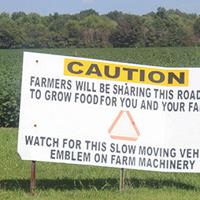
Agriculture and accidents have long been intertwined. The U.S. Occupational Safety and Health Administration places farming his 10th on its list of the most dangerous occupations.
According to OSHA, the farm-related accident fatality rate is 20.9 per 100,000 workers, mostly from accidents involving heavy equipment.
As technology advances, safety continues to be a consideration. However, some people worry that they may not be getting enough stress.
Sarah Issa, a professor at the University of Illinois who specializes in agricultural safety, expects 21st-century technology safety measures to catch up much faster than 20th-century technology. But he has concerns.
“We feel like we’re recreating a time in the early 1900s when people were so excited about what technology could do. and we were discussing whether to cover the crops, on,” he said.
Issa pointed out that although tractors were introduced around 1900, rollover protection was not commonly included until the 1970s. According to European research, about half of all tractors in use today are still not equipped with he ROP.
“It is sad that there are still deaths and injuries due to lack of ROP,” he said.
Partly due to labor shortages, the shift to self-driving cars continues.
John Deere recently rolled out a line of three self-propelled forage harvesters. The company said in a release that the model addresses the needs of products “challenged by increased operating costs, shortened harvest periods and a smaller pool of skilled workers.”
Other manufacturers are increasing their production of self-propelled and robotic machines. The adoption of such equipment raises safety issues.
Josie Rudolphi, Director of North Central Farm and Ranch Stress Assistance Center, said: “Autopilot is great technology, but it can keep farmers from taking their eyes off what’s in front of them.”
People are also reading…
Issa believes that safety has not been addressed enough as technology has changed.
“There hasn’t been much discussion about how this technology will interact with humans,” he said. “We think of it as a manufacturing facility with robots, with walls all over the place. You can’t do that in agriculture.
“It’s as simple as kids running into a field while a robotic machine is doing its job. So we have to talk about it.”
Rudolphi points out that many injuries are traffic related.
“When agricultural vehicles encounter non-farm vehicles, accidents can happen,” she said. We need to make sure that non-farmers are aware that farm vehicles move slowly and practice patience.”
My biggest fear is moving away from rural communities and into cities as we move to highly sophisticated systems,” he said. “How does it affect things and avoid it?”
Rudolfi also pointed out that modern communication technologies such as mobile phones can be a distraction during farm work.
Any discussion of on-farm hazards inevitably involves mental health. Although the farmer hasn’t faced economic stress like the agricultural crisis of the 1980s, stress is always a threat.
“We are constantly worried about stress and mental health,” said Rudolfi. “We need to make sure there are people around farmers who can provide positive social support.”
She leads the center, which includes resources such as help lines and referrals for professional assistance. Unlike in the 1980s, farmers are dealing with relatively positive economic signals. But stress is still prevalent in agriculture.
“We want to ensure that our farmer supporters are well trained in mental health literacy and can provide support when needed,” Rudolfi said. “Regardless of the commodity situation, the economy continues to be embarrassed and stressful for producers.”
